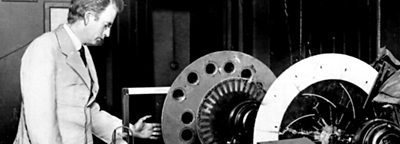John Logie Baird, born in 1888 near Glasgow, was a true inventor. At the age of 34, when he began his quest to develop television, he already had a string of business ventures behind him. He had narrowly failed to invent processes for the manufacture of industrial diamonds and the air-soled shoe. Other experiments ranged from a disastrous homemade haemorrhoid cream to a rustless glass razor (with which he had badly cut himself before abandoning the project).
But he had some successes, and with the capital left over from the sales of his socks and soap businesses, he rented modest premises and set about his experiments in television. It was the start of a passion which was to drive him for the rest of his life. Dogged by ill health, constantly short of funds and often working alone, he improvised his apparatus from scrap materials.
At the heart of his system was a large spinning disc. Invented by Paul Nipkow in 1883, this disc had a spiral of holes around the circumference through which light had to pass into a light-sensitive cell - a photocell. It was this arrangement of holes that would scan the image to be televised, but when the holes proved inadequate, he fitted them with lenses that would admit more light.
Desperate to increase the sensitivity further, he designed bigger and bigger discs with larger and larger lenses, culminating in a disc over eight feet in diameter with eight-inch lenses. Running at full speed - at 750 rpm - it was lethal. The heavy lenses flew off, bursting into shards of glass as they hit the walls, while the now unbalanced disc leapt about the laboratory before destroying itself.

Uninjured and undismayed, Baird continued his experiments and was able by early 1925 to mount a simple demonstration to the public. Selfridges department store in Oxford Street London was the unlikely setting for these shows. Bemused shoppers were treated to 'a recognisable, if rather blurred, image of simple forms such as letters printed in white on a black card.
The first system had only five scanning lines and was a 'shadowgraph' - it only displayed a silhouette outline image. What was needed for 'true television' (Baird's words) was a system that would create shades of grey and had enough detail in the picture to produce a recognisable image.
His experiments suggested to him that the minimum number of TV lines to produce a recognisable image of the human face was 30, and this was the standard he adopted. (It would have been fairly easy to increase the number of lines in the laboratory, but along with all the other television pioneers, he had the problem of limited bandwidth to amplify and transmit the signals.) Thus 'low definition' television was born.
Baird's breakthrough came on 2 October 1925 when he produced a recognisable image, complete with shades of grey. On 26 January of the following year he gave the world's first public demonstration of television.
A prolific inventor, by the end of 1928 Baird had gone on to claim a number of firsts:
- He developed a system of colour television in 1928 which later would form the basis of the technique used by NASA to bring live colour TV pictures from the moon (he continued to be fascinated by colour television, and in the 30s and 40s demonstrated colour pictures that were of outstanding quality).
- He demonstrated stereoscopic (3D) television in August 1928.
- His demonstration of Infra-red television (the basis of many modern CCTV security systems) caused a huge stir in the scientific and military world.
- Some 34 years before the USA claimed success with the 'first' transatlantic television pictures, Baird succeeded in transmitting live television pictures from London to New York.
- Foreseeing the need to be able to record television programmes, he developed 'Phonovision', a system of recording television on to discs. Baird was unable to successfully replay these recordings in 1928, but they have recently been restored and the world's first video recordings can now be seen.
